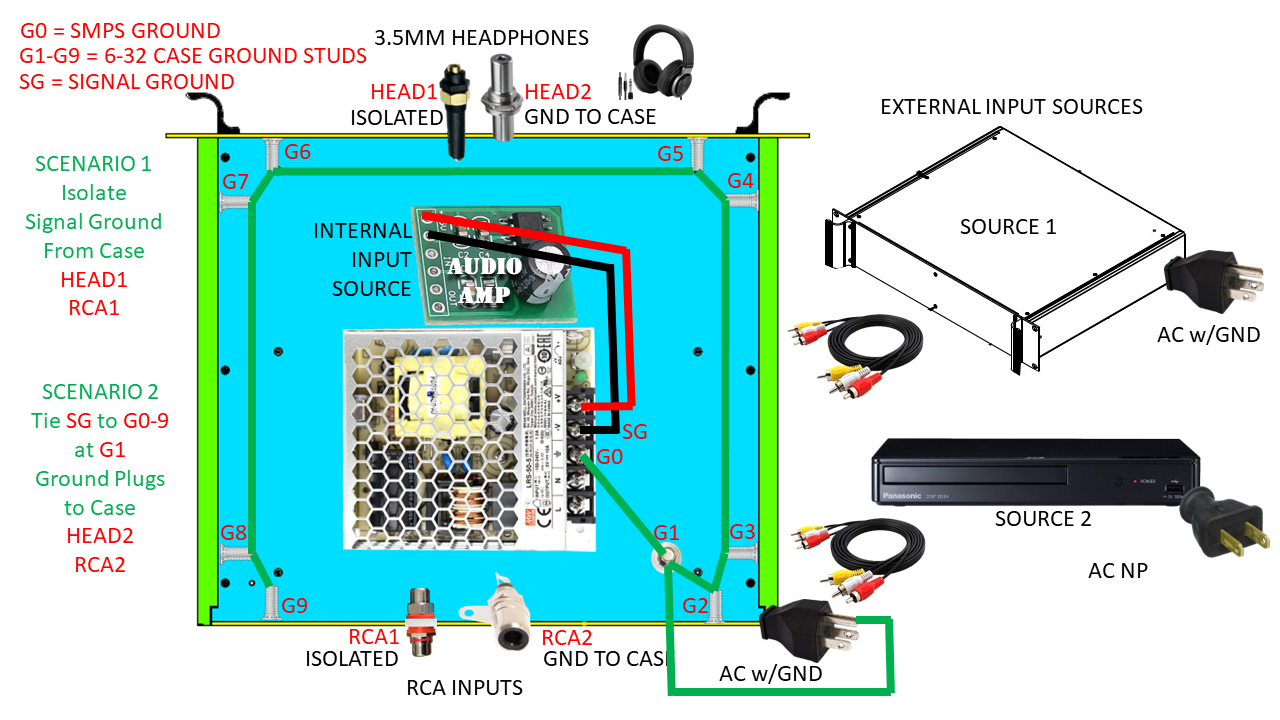I am a hobbyist in the process of building an audio/video project in a 2U aluminum box. I have reached the point where I must choose which type of RCA & 3.3mm jacks to use before I drill the holes in the front and back panels. I am using an Meanwell LRS-50-5 power supply
https://www.mouser.com/ProductDetail/MEAN-WELL/LRS-50-5?qs=vDxCgdWo2h9hVrbBDwCVQA%3D%3D&gclid=Cj0KCQjwnMWkBhDLARIsAHBOftoTK-S-3O6f98SINotCcdsZPV8FJ6Vxe4LAA7dXasDB-o4X7zxwCosaAqk5EALw_wcB.
I have read countless documents and viewed schematics on this subject but am still confused when it comes to physically building a box and running all of the wires correctly and safely.
I drew a very simplified pictorial diagram (shown at bottom of post) to give a better context to my questions.
I have a 2U aluminum cabinet with basically 5 pieces front, back, left, right. and bottom which are all screwed together with M3 screws. Each piece provides two 6-32 ground studs so that AC shorts won't have to travel through the M3 screws. Inside the cabinet I have a 5VDC SMPS and a simple internal analog audio amplifier. The following questions relate to grounding only, the internal analog amplifier could be any amplifier and is not the focus of my questions.
I am getting a reading of 14.7 VAC from AC ground to signal ground when I float the signal ground. If I jump the two together with an alligator clip while the unit is still on and the headphone amp turned all all the way up full blast with no input signal, I can barely hear any noise or clicking when the alligator clip is connected and disconnected by tapping it in and out. I expected there to be a very noticeable noise but not at all. With music playing as an input signal, the sound is crystal clear even when I do the alligator test. This makes me think maybe it makes no difference, but is safety an issue?
QUESTIONS, please advise which scenario I should use with relation to external audio source devices shown in diagram:
Scenario 1 In the diagram, see "Scenario 1" isolates/floats the signal ground and uses insulated RCA1 and HEAD1 plugs to prevent the plugs from grounding to the aluminum case. All grounds will be run to an insulated ground star not connected to the case.
When connecting external input sources such as those shown in the diagram, will there be any noise or safety issues caused by floating the ground? Note I have shown an external source using a non-polarized AC cord and another external source using a 3-prong AC plug w/ground.
Scenario 2 In the diagram, see "Scenario 2" uninsulated RCA2 and HEAD2 plugs with metal cases grounding directly to the aluminum case. I will run a separate ground wire from the -5V output of the SMPS to the ground star G1 on this case. Is it necessary to run separate ground wires from each plug to the ground star G1, or will the aluminum case serve as ground without creating ground loops?
Will there be any noise or safety issues when connecting external sources while the AC ground and signal ground connected together?
